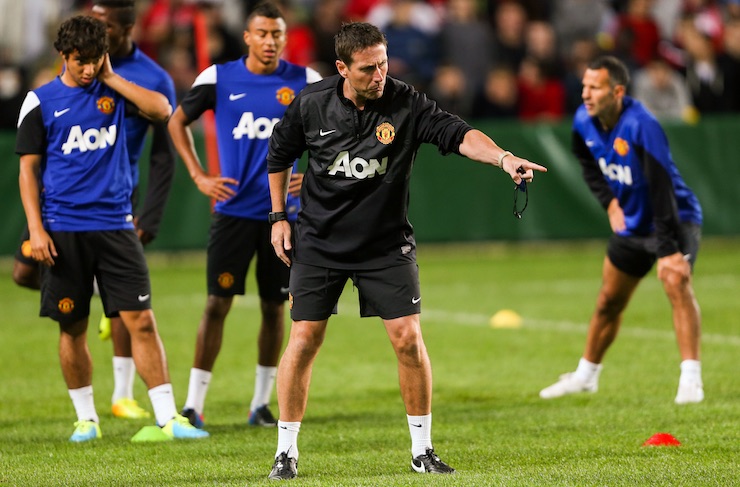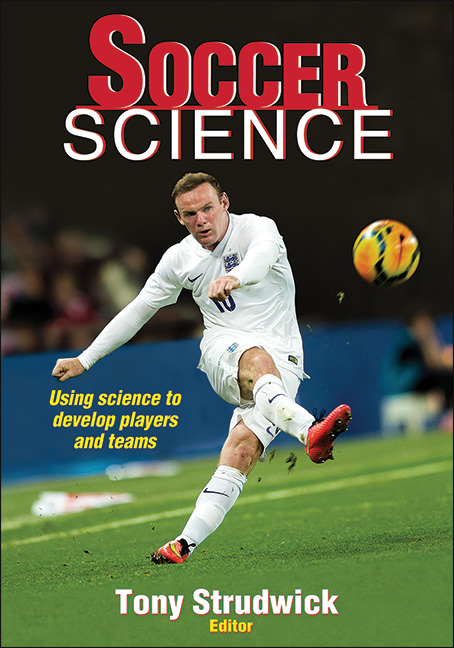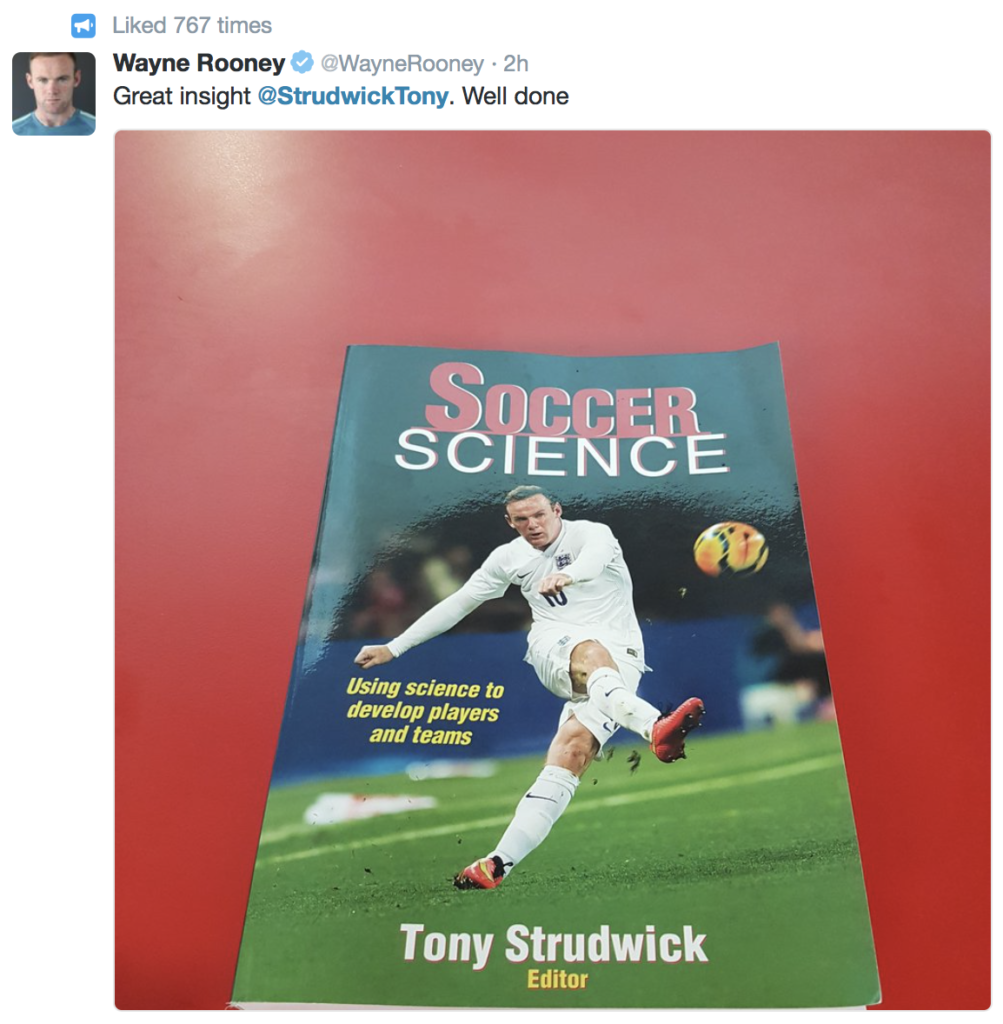Soccer Lover’s Book Reviews
It was almost a year ago we reviewed this book — and searching through our files, we rediscovered it again and wanted to remind the world how great this book really is!
The Soccer Lover’s Book Reviews rates books on the world’s most popular sport. Manchester United’s Tony Strudwick leads an all-star panel with the most current and important research on soccer — benefiting youth and professionals soccer coaches and players. Soccer Science features the world’s leading experts in soccer history, biomechanics, physiology, psychology, skill acquisition, coaching, tactical approaches, and performance and match analysis. If you are involved in the world of elite players — as a coach, trainer, director, parent or player — you need this book. Today, preparing soccer players for competition requires sport science information to successfully improve performance.
Rating: ESSENTIAL READ
‘Soccer Science’ Edited by Tony Strudwick
Tony Strudwick, Head of Performance, at Manchester United storied soccer club in Manchester, England is well known for his modern and innovative approach to developing professional soccer players and spent more than two years working on this amazing collection of information on the science of soccer. The book propels the game of soccer to new heights with valuable and useable information on how to help develop players. Soccer Science — is just that, a book brimming with scientific information which can make a difference in the development of youth as well as professional soccer players.
“My favorite part of working on the book Soccer Science was trying to bring the coaching information alive, especially on the principals of play,” said Tony Strudwick in an exclusive interview. “The book is loaded with key tips for developing players. I would like the book to achieve a global reach.”
Getting to the heart of it, Soccer Science is a very usable book,” says Strudwick who also trained players at Blackburn Rovers Football Club and West Ham United F.C. before joining Manchester United. Strudwick has also worked with the English FA for years.
“There is information in Soccer Science that can be applied immediately in a coach’s training session — whether the coach is coaching a professional EPL or MLS team or is a youth soccer coach.” From a player’s capability to generate power to the principles of attack, Soccer Science provides invaluable insights which apply regardless of the system of play and formation played by the team.
With editor Strudwick and an impressive who’s-who list of international experts on the sport, Soccer Science offers you an unprecedented wealth of advanced yet accessible information on biomechanics, physiology, psychology, skill acquisition and coaching, tactical approaches and performance and match analysis. It is simply the most significant and comprehensive published work on the sport.
“It is a fantastic book,” said Strudwick who urges coaches to use the book as it will make a difference in their coaching.

When asked how has science impacted soccer, Strudwick answered, “When I first started coached more than 20 years ago, sport science was in its infancy. We have enjoyed some real technology advancements, which have allowed us to really know that is going on in the critical parts of the game. Now, more than ever before, coaches can meet the specific needs of a player.”
“The book is very pratical and appeals to all students of the game,” said Strudwick.
“I am most excited that Soccer Science actually transfers sports science that useable — a coach can read a chapter and use the information immediately in a training session.”
With editor Tony Strudwick and a who’s-who list of international experts on the sport, Soccer Science offers you an unprecedented wealth of advanced yet accessible information on biomechanics, physiology, psychology, skill acquisition and coaching, tactical approaches and performance and match analysis. It is simply the most significant and comprehensive published work on the sport.
Strudwick, who was recruited by Sir Alex Ferguson and helped to shape a state-of-the-art sport science laboratory at the AON Training Complex, stresses that the integration of soccer science should be a normative activity in the coaching process. Strudwick is highly respected among the top players in the world. Below see Wayne Rooney’s Twitter post:
“Soccer science is underpinned by concrete scientific principles that have been recognized as key ingredients in assisting those with talent, commitment, and interest in reaching their potential,” he says. “In these circumstances, the objectives of soccer science have to be unambiguous and linked to an overall coaching strategy.” Moreover, everyone involved—coaches, administrators, support personnel, and athletes—need to understand and accept soccer science. Not only that, it must be communicated well enough to establish performance indicators that can be used to monitor progress.
Featuring contributions from the world’s foremost authorities from the English Premier League, Major League Soccer, European and Champions League teams, senior international teams, FIFA medical staff, international soccer consultants, and leading academic institutions, Soccer Science offers an unprecedented wealth of advanced yet accessible information.
What is the biggest mistake coaches make in the youth soccer world?
The biggest mistake in youth market is imposing our adult structure on young children. If you look at the heart of player development, we are still not getting it right. The problem is that some people still see success as winning games, not as the end of a journey.”
Everyone agrees that experiential and science-based knowledge abounds in the sport — yet the scientific information has not been sufficiently disseminated to those who would benefit most from it. Soccer Science fills the void with the best and most up-to-date research in the sport.
Available on Amazon and Human Kinetics, Soccer Science features the world’s leading experts in soccer history, biomechanics, physiology, psychology, skill acquisition, coaching, tactical approaches, and performance and match analysis.
One the back of the book, you can read,“Through the years a wealth of information has been accumulated in soccer. Experiential and science-based knowledge abounds in the sport. Yet the scientific information has not been sufficiently disseminated to those who would benefit most from it. Soccer Science fills the void with the best and most up-to-date research in the sport. With editor Tony Strudwick and a who’s-who list of international experts on the sport, Soccer Science offers you an unprecedented wealth of advanced yet accessible information on biomechanics, physiology, psychology, skill acquisition and coaching, tactical approaches and performance and match analysis. It is simply the most significant and comprehensive published work on the sport.”
Soccer Science includes chapters on the following:
Chapter 1. Evolution of Soccer Science (Neil Carter)
Chapter 2. National and Cultural Influences (Craig Duncan and Tony Strudwick)
Part II. Talent Identification and Player Development
Chapter 3. Practical Aspects of Player Selection and Development (Iñigo Mujika and Carlo Castagna)
Chapter 4. Development of the Young Soccer Player (Viswanath Unnithan and Jon Iga)
Chapter 5. Skill Acquisition and Learning Through Practice and Other Activities (Paul Ford)
Part III. Biomechanical and Technological Applications
Chapter 6. Biomechanical Principles of Soccer (Anthony Blazevich and Sophia Nimphius)
Chapter 7. Refining Techniques and Skills Through Scientific Analysis (Neal Smith)
Chapter 8. Biomechanics for Optimal Performance and Injury Prevention (Martin Haines and Daniel Cohen)
Chapter 9. Soccer Boots and Playing Surface (Thorsten Sterzing)
Chapter 10. Soccer Ball Dynamics (Andy Harland and Henry Hanson)
Part IV. Physiological Demands in Training and Competition
Chapter 11. Targeted Systems of the Body for Training (Greg Dupont and Alan McCall)
Chapter 12. Conditioning Programmes for Competitive Levels (Tony Strudwick and Gary Walker)
Chapter 13. Environmental Stressors (Donald T. Kirkendall)
Chapter 14. Nutritional Needs (Mayur Ranchordas)
Chapter 15. Injury Frequency and Prevention (Dr. Mario Bizzini and Dr. Astrid Junge)
Part V. Psychology and Mental Demands
Chapter 16. Psychology and Elite Soccer Performance (Geir Jordet)
Chapter 17. Mental Interventions (Matt Pain)
Chapter 18 Performance Mindset (Mark Nesti)
Part VI. Tactics and Strategies
Chapter 19. Popular Systems and Styles of Play (Jens Bangsbo and Birger Peitersen)
Chapter 20. Defensive Pressure and Goal Prevention (Sam Erith and Gary Curneen)
Chapter 21. Key Transitions and Midfield Maneuvers (Dave Tenney and Sigi Schmidt)
Chapter 22. Essential Elements of Attacking Soccer (Richard Hawkins and Darren Robinson)
Part VII. Match Performance and Analysis
Chapter 23. Player and Team Assessments (Rob Mackenzie and Chris Cushion)
Chapter 24. Match Evaluations: Systems and Tools (Chris Carling)
Chapter 25. Statistical Evaluations in Soccer (Ron Smith)
Epilogue: The Future of Soccer Science (Tony Strudwick)
Originally published on July 27, 2016 and republished to remind our readers!








